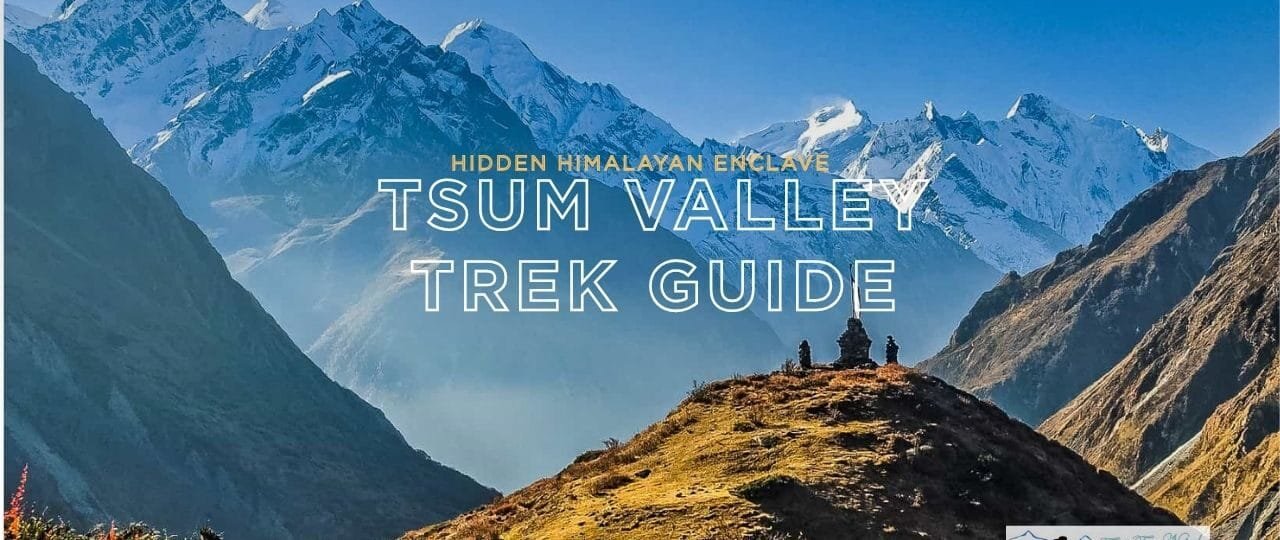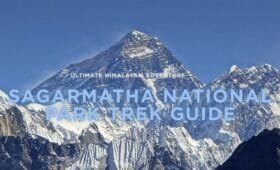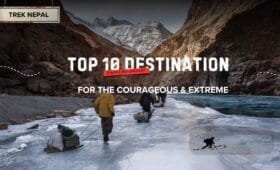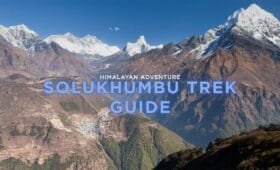The Tsum Valley Trek offers a rare window into one of Nepal’s most secluded Himalayan subcultures. Located north of the Manaslu region, this journey delves into a mystical land shaped by Tibetan Buddhism, centuries-old monasteries, and breathtaking mountain vistas. If you dream of escaping well-trodden paths like Everest or Annapurna, the Tsum Valley Trek stands out as a mesmerizing alternative. Here, stone-walled villages and chortens punctuate highland slopes, and the valley’s name—“Tsombo,” meaning “vivid”—aptly captures its vibrant cultural tapestry and dramatic landscapes.
In this comprehensive Tsum Valley Trek guide, we’ll explore every facet of the Trek. That includes the standard Tsum Valley Trek Itinerary, Tsum Valley Trek Cost pointers, route details, difficulty levels, best seasons, and how you can merge your trek with philanthropic endeavors via Volunteers Initiative Nepal (ViN). Whether you’re a cultural enthusiast craving interaction with age-old Buddhist traditions or an adventurer wanting a scenic yet less-crowded challenge, the Tsum Valley Trek promises a profound blend of nature’s splendor and spiritual depth.
Introuduction
1. Introduction: Why the Tsum Valley Trek?
Often overshadowed by Manaslu or Annapurna routes, Tsum Valley Trek remains a lesser-known gem. This region, demarcated as a “sacred Himalayan pilgrimage valley,” fosters a strong Buddhist heritage, dotted with prayer flags and centuries-old monasteries. Fewer trekkers choose Tsum, preserving its intangible cultural essence. The local residents—Tsumbas—trace Tibetan ancestry and speak a unique dialect. Their daily life is shaped by barley fields, yak herding, and deep-seated Buddhist faith.
Statistic: According to the Nepal Tourism Board, under 3,000 foreign adventurers annually attempt the Tsum Valley corridor, dwarfed by tens of thousands heading to Manaslu or Everest. This ensures minimal crowds, guaranteeing an immersive, authentic Himalayan experience. Meanwhile, the Tsum Valley Trek offers moderate altitudes (mostly below 4,000m), making it accessible to those with decent fitness, yet it remains sufficiently challenging with rugged trails and occasional high passes.
“The Tsum Valley Trek was enlightening—tranquil villages, ancient gompas, and an unmistakable vibe that I’d stepped into a living museum of Tibetan culture,”
recalls Katrin, a 31-year-old German trekker who completed the route last autumn.
History
2. Historical & Cultural Overview
The Tsum Valley historically served as a trade nexus between Nepal’s northern highlands and Tibet. Derived from “Tsombo,” meaning “vivid,” Tsum was once closed to outsiders, preserving customs like polyandry and a devout Buddhist ethos influenced by the teachings of Guru Rinpoche (Padmasambhava). Villages across Tsum Valley Trek Route exhibit intricate mani walls, prayer wheels, and chortens reminiscent of Tibetan architecture.
Despite being open to foreign trekkers only since 2008, Tsum retains intangible cultural gems—exemplified by centuries-old monasteries such as Rachen Gompa and Mu Gompa. Residents still practice non-violence to animals, adhering to “Nyingma” Buddhism’s ethos. Over time, careful yet minimal infrastructure expansions have accommodated trekking visitors with teahouses or homestays while safeguarding local traditions. The Tsum Valley Trek thus merges scenic ridgelines and deep gorges with an immersion in living Buddhist heritage rarely found in more commercialized trekking zones.
Trek Itinerary
3. Key Highlights of Tsum Valley Trek Itinerary
While you can adapt it, a typical Tsum Valley Trek Itinerary might span 14–18 days, often overlapping part of the Manaslu Circuit route. Below is a representative outline:
Day 1: Kathmandu → Arughat → Soti Khola (~700m)
A ~7-8 hour jeep/bus drive from Kathmandu, lodging near Soti Khola or Machha Khola to start the on-foot journey.
Day 2–3: Soti Khola → Machha Khola → Jagat (~1,340m)
Gentle ascents across farmland, with waterfalls and suspension bridges. Jagat is a checkpoint for restricted permit checks.
Day 4: Jagat → Lokpa (~2,240m)
Branch off from the main Manaslu trail. Enter Tsum Valley territory. The valley narrows, unveiling first glimpses of southwestern Ganesh Himal.
Day 5: Lokpa → Chumling (~2,386m)
Trails ascend forested ridges. Encounter small chortens with carved mani stones showcasing local devotion.
Day 6: Chumling → Chhokangparo (~3,010m)
Gradually, the valley broadens. Terrace fields and scattered stone houses define Tsumbas’ livelihood. Breathtaking panoramas of Himalchuli, Ganesh Himal.
Day 7: Chhokangparo → Nile (~3,361m) or Mu Gompa (~3,700m)
Approach Tsum’s cultural heart. Mu Gompa is the region’s apex monastery, perched in scenic solitude. Some choose to overnight near Nile, then day-hike to Mu Gompa.
Day 8: Mu Gompa Exploration
Visit Mu Gompa (~3,700m) or further vantage points nearing ~4,000m. Observe monastic life, the valley’s symmetrical peaks, or yak herds in high pastures.
Day 9–10: Return Descent
Retrace steps to Chumling or rejoin the Manaslu route near Philim. Some might incorporate a side loop to Ganesh Himal base vantage if time permits.
Day 11–14: Trek Out to Soti Khola
Reverse your path or loop partially on the Manaslu Circuit. Eventually bus/jeep back to Kathmandu.
Tsum Valley Trek Duration may be extended by adding side trips like Ganesh Himal base camp or advanced exploration near Mu Gompa. Others merge Tsum with the full Manaslu Circuit, extending the trip to over three weeks.
Trek Difficulty
4. Understanding Tsum Valley Trek Difficulty
Compared to EBC or Annapurna Circuit altitudes, the Tsum Valley Trek Difficulty is moderate to challenging. Although altitudes around 3,700–4,000m are not extreme, daily ascents can be steep, especially above Chhokangparo or Mu Gompa. The biggest obstacles:
- Remote Logistics: Access via local roads or bus rides can be lengthy. Infrastructure remains basic, especially past Jagat or Lokpa.
- Steep Trails: Tsum valley transitions from ~700m near Soti Khola to ~3,700m at Mu Gompa, requiring ~3 weeks to incorporate rest days and ensure safe acclimatization.
- Occasional High Passes: Some side expansions pass vantage ridges topping 4,000m. Weather changes can hamper trail conditions in monsoon or winter.
Trekkers with average fitness and some multi-day altitude trekking experience typically handle Tsum’s demands well, provided they ascend gradually. A rest day near Chhokangparo helps altitude adjustment if climbing beyond ~3,500m.
Trek Mapping
5. Tsum Valley Trek Route & Tsum Valley Trek Map
Tsum Valley Trek Route starts from Soti Khola or Machha Khola, following the Budhi Gandaki River upstream. The main departure from the Manaslu route happens near Philim (~1,570m), branching into Tsum’s narrower gorge. The key villages are Lokpa, Chumling, Chhokangparo, and Nile, culminating near Mu Gompa.
A good Tsum Valley Trek Map is crucial, especially after leaving the main Manaslu corridor. Some paths meander through forested ravines or cliffside ledges. If you intend side expansions like Ganesh Himal base vantage, you’ll rely heavily on local guides or your trek staff’s knowledge. Distances vary, but expect ~5–7 hours of daily trekking with altitudinal gains of 400–600m.
Tsum Valley Trek Distance from Soti Khola to Mu Gompa and back is ~160–200 km total, depending on side loops. The region’s intricacy underscores the advantage of traveling with an experienced Tsum Valley Trek Guide and a thorough route plan.
Costing
6. Typical Tsum Valley Trek Cost
Tsum Valley Trek Cost surpasses popular teahouse routes primarily due to restricted permits and less-developed lodging. Key cost components:
- Transport:
Local bus or jeep from Kathmandu to Soti Khola ~USD 10–20. Private jeep ~USD 150–200.
- Permits:
- Manaslu Conservation Area Permit (~USD 30).
- Tsum Valley restricted permit (~USD 35 per person/week, or ~USD 70 after extended days; vary by season).
- Possibly an Annapurna Conservation Area Permit if looping or merging routes (~USD 30).
- TIMS card (~USD 10–20) if demanded.
- Teahouse or Basic Lodging:
Teahouses in Tsum remain simpler, ~USD 3–6/night for a bed. Some spots may have communal lodging.
- Guide & Porters:
Mandatory guide for the restricted Tsum region. ~USD 25–30/day for a guide, ~USD 15–20/day for porters.
- Meals:
Dal bhat, noodles, momos. Budget ~USD 20–25 daily.
- Misc:
Hot shower (~USD 2–4), device charging (~USD 1–3), plus contingency for emergencies or changes.
All told, a ~14-day Tsum trip might cost ~USD 800–1,300 if done simply. A more comfortable Tsum Valley Trek Package, including a guide, porters, transfers, and partial meals, could be ~USD 1,200–1,800, depending on group size and daily comfort level.
Trek Packages
7. Book the Right Tsum Valley Trek Package
Tsum Valley Trek Package solutions from agencies streamline logistics in this lesser-known region. Typical packages cover:
- Transport: Jeep to Soti Khola, then back from Arughat or similar points.
- Permits & Paperwork: The restricted Tsum permit, MCAP, ACAP if merging, plus any local fees.
- Guide & Porters: Facilitating route knowledge, bridging language with Tsumbas, ensuring route safety.
- Teahouse/ Homestay Reservations: Tsum’s limited lodging can fill up in prime seasons.
Reading Tsum Valley Trek Reviews helps ascertain an agency’s reliability. Check their stance on ethical wages for staff, group sizes, itinerary flexibility, and cultural immersion opportunities. A well-structured package offers peace of mind in such remote territory.
Trek Permits
8. Permits & Paperwork: Tsum Valley Trek Permits
Traversing Tsum’s restricted region demands special documentation. Key Tsum Valley Trek Permits:
- Tsum Valley Restricted Permit:
- ~USD 35 per person/week (Sept–Nov) or ~USD 25 (Dec–Aug), with potential increments after 7 days.
- Must trek with a licensed guide, minimum group size typically 2, though some agencies handle “ghost permit” for single trekkers.
- Manaslu Conservation Area Permit (MCAP):
- ~USD 30 for foreigners.
- Annapurna Conservation Area Permit (ACAP):
- Only if you connect with Annapurna area in certain route expansions.
- TIMS Card:
- Potentially required, though some restricted region rules can vary.
Carry your passport, visa copies, and multiple passport photos. If you choose a Tsum Valley Trek Package, the agency arranges permits. Keep them with you, as local checkpoints (e.g., Jagat) will verify them.
Trek timing
9. Tsum Valley Trek Best Time & Weather
Tsum Valley Trek Weather patterns align with much of central-north Nepal:
- Autumn (Sept–Nov): Crisp, stable, ~15–20°C at lower altitudes, near 0°C at night around 3,000–3,500m. Clear mountain vistas, busiest period for trekking.
- Spring (Mar–May): Blooming rhododendrons, moderate temperatures, occasional haze or afternoon thunderstorms. Crisp mornings for scenic photography.
- Winter (Dec–Feb): Sub-zero nights above ~3,000m, potential heavy snow on higher vantage ridges or passes. Quieter trails if you handle cold.
- Monsoon (Jun–Aug): Rains hamper roads, risk of landslides. Tsum’s gorge might see leeches in lower forest. Some consider it an off-peak challenge.
Tsum Valley Trek Best Time is typically autumn or spring for pleasant conditions and minimal precipitation. If you want solitude, early winter can be viable, though lodging in remote areas might partially shut down.
Trek Altitude
10. Altitude & Safety: Tsum Valley Considerations
The Tsum Valley Trek Altitude rarely exceeds ~3,700–4,000m near Mu Gompa or certain vantage points. Though not extreme, altitude sickness remains possible, especially if you ascend rapidly. Key safety measures:
- Gradual Ascent: Plan rest days if climbing beyond ~3,400m.
- Hydration: ~3 liters daily. Watch for headaches or appetite loss.
- Local Knowledge: A Tsum Valley Trek Guide ensures route pacing, helps interpret local conditions, and responds to emergencies.
Tsum Valley Trek Elevation climbs from ~700m near Soti Khola to ~3,700m around Mu Gompa. Temperature swings can be stark. Also, ensure your insurance covers trekking up to 4,000m or more, given unpredictability in remote settings.
11. Lodging & Meals: Tsum Valley Trek Accommodation
Tsum Valley Trek Accommodation typically revolve around teahouses or basic homestays in villages like Chumling, Chhokangparo, Nile, and Mu Gompa’s vicinity:
- Teahouses: Basic wooden rooms, shared bathrooms, limited electricity. Dal bhat (lentil-rice), noodle soup, or Tibetan bread form typical meals.
- Homestays: Some Tsumba families open their homes to trekkers. This fosters cultural exchange but expect minimal frills—communal sleeping areas or squat toilets.
- Camping: Less common in Tsum if teahouses suffice, but some choose tents for side expansions or if teahouses are full in peak season.
Even in these simpler setups, the warmth of local hospitality stands out. Communal dining rooms double as evening gatherings, where you can learn about Tsumba traditions.
FAQs
12. Most Frequently Asked Questions
Below are seven common queries from travelers exploring Tsum:
How long is the Tsum Valley Trek Duration?
Typically 14–18 days, plus buffer for transport. Some do a short 10–12 day version focusing solely on Tsum’s core villages.
What is the Tsum Valley Trek Difficulty rating?
Moderate to challenging. While maximum altitudes are ~3,700–4,000m, daily ascents can be steep, especially beyond Chhokangparo.
How much does the Tsum Valley Trek Cost?
Expect ~USD 800–1,300 for 2 weeks if going teahouse style. A Tsum Valley Trek Package with a licensed guide, permits, etc. might be ~USD 1,200–1,800.
Which Tsum Valley Trek Permits are needed?
Tsum restricted permit (~USD 35/week peak season, ~USD 25/week off-season), plus MCAP (~USD 30). Possibly a TIMS card or additional fees if linking with Manaslu or Annapurna areas.
When is the Tsum Valley Trek Best Time?
Autumn (Sept–Nov) or spring (Mar–May). Winter sees colder nights, monsoon has heavy rain. Autumn offers stable, clear vistas.
Is a Tsum Valley Trek Guide mandatory?
Because Tsum is restricted, you need at least a guide or two trekkers with a recognized trekking agency. A guide is highly recommended for cultural immersion and route navigation.
What about Tsum Valley Trek Reviews and user feedback?
Many highlight Tsum’s cultural authenticity, scenic tranquility, and warm local interactions. Infrastructure is basic, so prepare for rustic conditions but a deeply rewarding experience.
Additional Tips
13. Additional Tsum Valley Trek Tips
13.1 Physical Prep & Packing
- Cardio: Sustain running or brisk hiking for ~6 weeks pre-trek.
- Strength: Weighted lunges, stairs replicate steep trails.
- Essentials: Fleece layers, a down jacket, sturdy boots, water purification method, quick-dry clothes.
13.2 Minimizing Environmental Impact
- Trash: Carry in, carry out. Tsum’s remote setting lacks robust waste disposal.
- Local Goods: Purchasing from local shops fosters economic benefits.
- Tsum Valley Trek Route: Stick to official trails, respect farmland boundaries.
13.3 Adapting to Cultural Norms
- Donations & Volunteering: Direct, respectful interactions ensure your help is truly beneficial.
- Photography: Ask before snapping locals or monastery interiors.
- Modest Dress: Especially near religious sites.
Community Empowerment
Making a Double Impact: Trekking with Volunteers Initiative Nepal
One unique advantage of trekking in Tsum is the opportunity to forge a deeper connection through philanthropic engagement. Volunteers Initiative Nepal (ViN) organizes charity trekking and travel tours, with all proceeds channelled to community empowerment. This synergy merges your Himalayan quest with tangible improvements for the region’s education, healthcare, or infrastructure.
1 Ways to Collaborate with ViN
- Volunteer: Dedicate extra days to teaching English or assisting health awareness programs in Tsum Valley’s small schools or clinics.
- Internship: Merge academic research—like sociology or environmental studies—with real on-ground needs.
- Donation: Even modest contributions can strengthen local initiatives, from water supply systems to school expansions.
2 Share with Friends & Families
Encourage others to embrace Tsum’s intangible wonders while fueling local empowerment. By highlighting the philanthropic aspect—“double impact” trekking—your journey extends beyond personal gain, forging lasting goodwill in remote Himalayan villages.
Conclusion: The Tsum Valley’s Sacred Allure
The Tsum Valley Trek epitomizes a hidden Himalayan wonder—fusing gentle altitudes, Tibetan-influenced culture, and incomparable calm. While overshadowed by famed routes like Manaslu or Annapurna, Tsum stands alone in its spiritual hush, ephemeral mountain vistas, and warm community welcomes. Each day unveils monasteries perched on ridges, farmland carved into steep hillsides, and footprints left by just a trickle of outsiders.
By weaving philanthropic synergy with your Tsum journey—through volunteering, donation, or an internship with ViN—you amplify your trek’s meaning. This makes a “double impact,” elevating local well-being as you glean the valley’s serene blessings.
Namaste—may your footprints across Tsum’s scenic path reflect empathy, forging a sustainable future for the region’s enduring cultural tapestry.
More information
Extended Practical Guidance & Final Inspiration
To consolidate your Tsum Valley planning, let’s finalize deeper insights:
1. Route Adjacency: Manaslu & Tsum Combined
Some trekkers merge Tsum with the Manaslu Circuit:
- Manaslu Circuit typically 14 days.
- Tsum Valley adds 7–10 days.
- Combined route hits altitudes of ~5,160m (Larkya La). This synergy can exceed 3 weeks, demanding a robust schedule and extra restricted permits.
2. Potential Challenges
- Flight or Road Access: Reaching Soti Khola or Arughat might involve a ~7–8 hour bus/jeep ride from Kathmandu. In monsoon or landslide season, prepare for unpredictability.
- Limited Connectivity: Fewer Wi-Fi or charging points, especially after Lokpa. Carry extra power banks or solar chargers.
- Weather Delays: If traveling in winter or monsoon, check local advisories on pass closures or road blockages.
3. Post-Trek Options
After Tsum, some travelers:
- Extend time in Gorkha region, exploring historical sites or other micro-adventures.
- Combine an easy route to Annapurna or keep the synergy with extended volunteering in other rural outposts.
- Return to Kathmandu for cultural tours, from UNESCO heritage sites to bustling Thamel markets.
4. Quick Review
- Tsum Valley Trek Best Time: Autumn or spring for stable weather, mild temps.
- Tsum Valley Trek Permits: Tsum restricted permit, MCAP, possibly ACAP if linking.
- Tsum Valley Trek Duration: ~14–18 days, or 10–12 if focusing only on Tsum’s main enclaves.
- Tsum Valley Trek Difficulty: Moderate-challenging, with altitudes around 3,700–4,000m.
- Tsum Valley Trek Accommodation: Basic teahouses or homestays, plus your own gear for comfort.
5. Final Encouragement
By selecting the Tsum Valley Trek, you sign up for more than scenic summits and cultural snapshots. You embark on a spiritual corridor shaped by centuries of Buddhist devotion, forging memories in an environment that merges natural splendor with the intangible hush of a valley deeply connected to Tibetan heritage. It’s a place to reflect, discover, and possibly give back in ways that meaningfully strengthen local communities.




